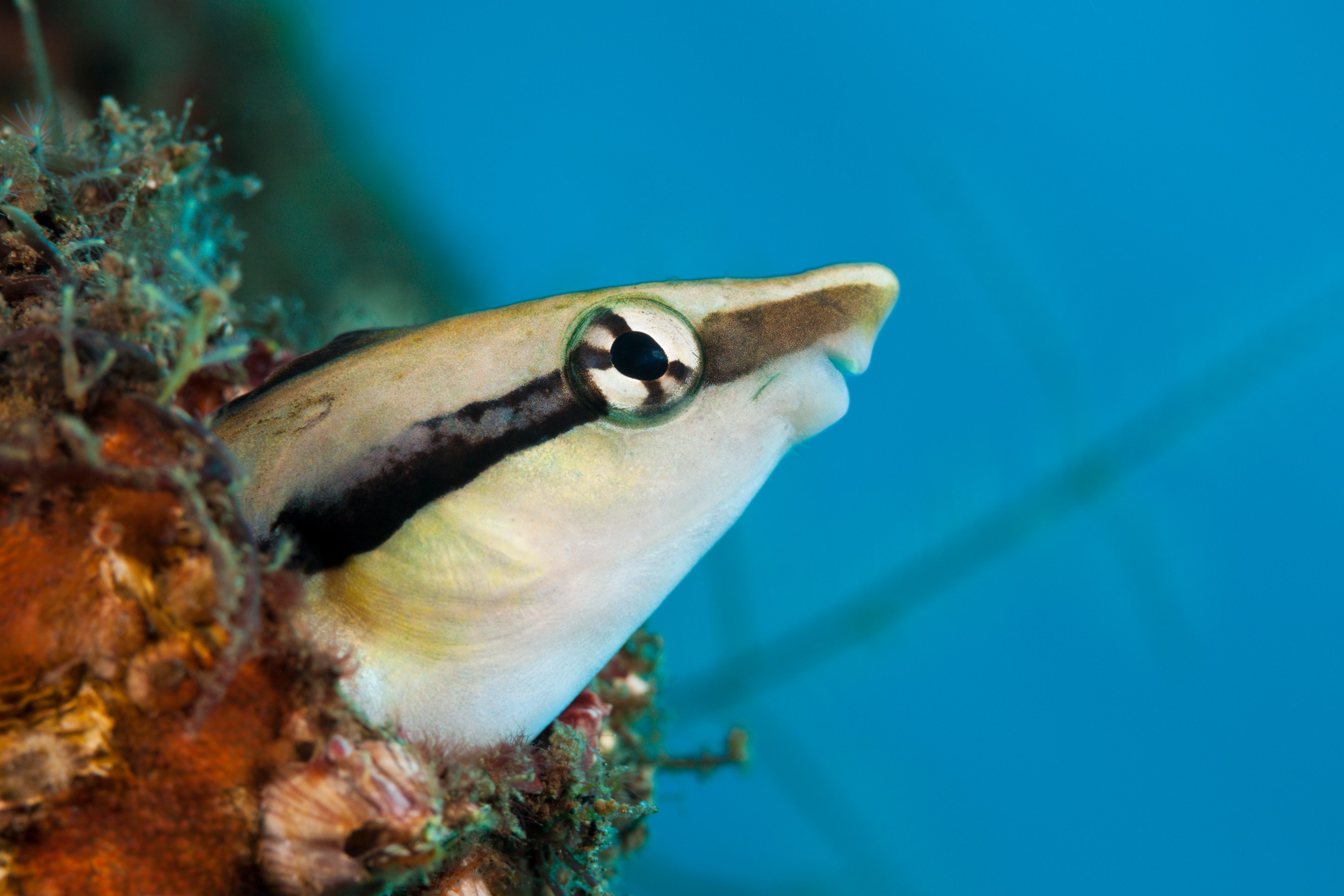If the false cleanerfish had a sleeve, it would be full of tricks. This species of blenny has a blue body with a long black stripe, making it look nearly identical to the much less devious fish, known as the bluestreak cleaner wrasse. The false cleanerfish is a skilled mimic—as a juvenile, it even resembles the real cleaner wrasse's adolescent appearance, where the fish is all-black with one electric blue stripe running down its back. Real bluestreak wrasses will groom fish that swing by their cleaning stations, plucking off dead skin, ectoparasites, and infected tissue. It's a classic example of symbiosis—the bigger fish can shed unwanted pests and the little wrasses get a meal. If the false cleanerfish lures in a potential client, however, it has no interest in cleaning. Instead, it will bite off small chunks of their fins and scales.
Scientists suspect the false cleanerfish did not evolve their appearance expressly to hustle other fish; rather, this blenny avoids getting eaten because it looks so similar to a species that many larger, predatory fish prefer to keep around. Once the blenny gained this protection, the fin-biting was simply a bonus—a snack too good to pass up. But most blennies, especially the ones that grow too long to pass as a cleaner wrasse, primarily subsist off hunting its preferred foods, which include fish eggs, tentacles from bristleworms, and the fleshy insides of bivalves.
In the warmer months off the island of Okinawa, Japan, the blennies feast on the juicy eggs of damselfish. Female damselfish lay their eggs on the reef, leaving the males to guard and aerate the eggs until they hatch. The male damselfish is a fierce protector, able to fend off a single egg-eating blenny on his own. But a group of scientists from Japan have now observed that the false cleanerfish know how to collaborate with each other; the hungry blennies are now teaming up to outwit damselfish dads. Their research was recently published in the Journal of Ethology.
Scientists consider collaboration, in which individuals split up different tasks, to be the most complex kind of group hunting. The behavior has been observed in the species you would expect. Forest chimpanzees hunt their prey by dividing into a driver, a blocker, a chaser, and an ambusher. But collaboration is not unique to primates. In the ocean, giant moray eels collaborate with enormous fish called groupers, taking turns ambushing and pursuing prey to achieve more hunting success than either would on their own. And the yellow saddle goatfish hunts alongside others of its own species, with some fish chasing prey and others blocking the prey's escape route.
In 2019, the researchers snorkeled around the shallow reefs off Okinawa to try and catch false cleanerfish in the act. They observed the blennies teaming up against 13 species of damselfish and even one triggerfish. In one instance, five blennies waited to raid a three-spot damselfish nest clinging to the surface of some boulders in the sand. While the damselfish dad patrolled the nest, chasing away any cleanerfish that came too close, the researchers watched as the largest blenny made a rush toward the nest, spurring the damselfish dad to chase him down. But that large blenny was a decoy. It swiftly changed directions, swimming away from the nest to lure the damselfish away while the other blennies swooped in to munch on the eggs. (You can watch a video of a similar attack here.)
In another instance, three false cleanerfish lurked behind a large rock near a damselfish nest. When one of the blennies poked its head above the rock to watch the nest, the damselfish dad chased it down, allowing the other hiding blennies to jet out of hiding and make a beeline toward the eggs. In another raid, the blennies once again split into "watchers" and "hiders" and successfully ambushed the nest, eating every last egg within 19 seconds, at which point the stomachs of three tricky blennies were swollen with eggs. (You can watch a video of this attack here.)
After false cleanerfish hatch, they spend their babyhood drifting in the open water before settling down on a reef, meaning the blennies that wind up at a particular reef are probably not related. Still, these strangers manage to work together to scam damselfish parents out of their freshly laid egg clutches. In these cooperative hunts, splitting the roles mean that sometimes certain blennies are more likely to get nipped or chased. But working together gives the blennies a much better chance at eating any eggs at all.
What can we learn from all of this? Eating some eggs is always better than eating no eggs. There is some justice in a famously fin-nipping fish getting its own fins nipped back in return. And, perhaps most poetically, for false cleanerfish, there is honor among thieves. Perhaps it is time to revisit the idea of a movie about fish scamming other fish, an idea that has historically led to garbage. I dare the Oceans franchise to actually live up to its name and make a movie with an all-fish cast aiming to pull off the biggest heist of damselfish eggs this reef has ever seen!






